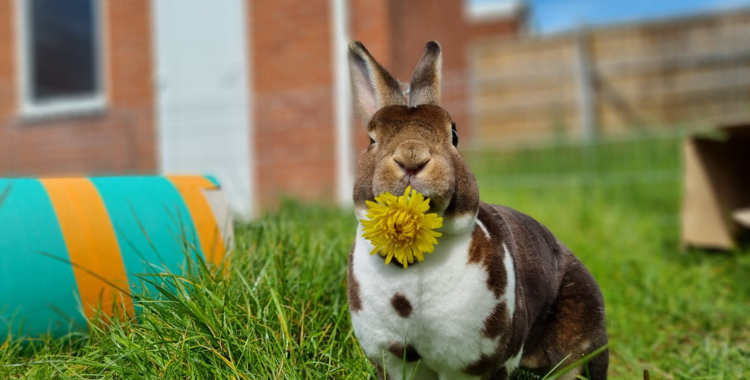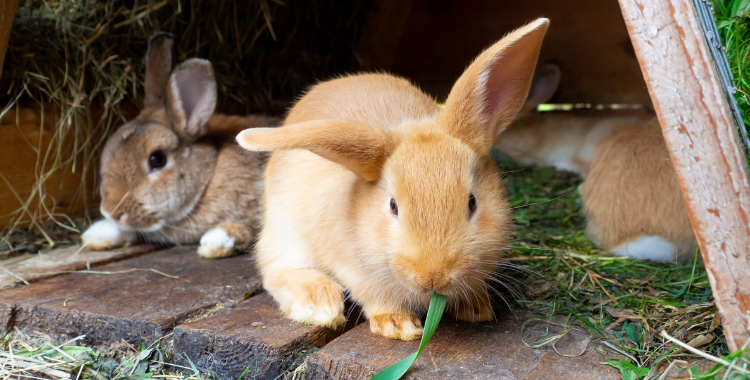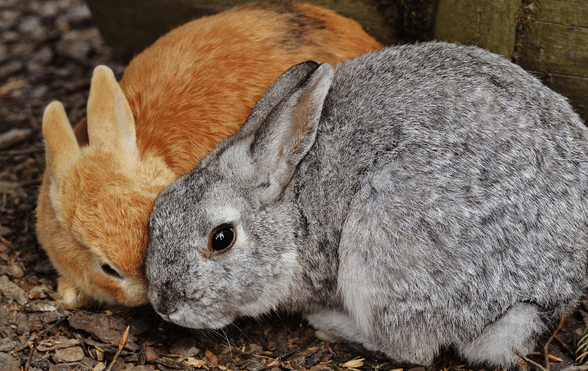Feeling the effects of the cost of living crisis or simply trying to save more money? Read our guide which explores ways to save money as a rabbit owner.
Is your rabbit insured? Get a quote for £2,000 of vet fee cover | Insure up to 3 pets per policy | We’ve been insuring exotic pets since 1996 | Check out our customer reviews on Feefo.
Rabbits make great pets and are generally a little cheaper to own than canine or feline friends. However, that being said, you’ll still be responsible for a number of costs when owning a bun such as food, hay, bedding, insurance and any veterinary costs.
Keep reading to learn some ways you can save money whilst owning a rabbit, without impacting their quality of life.
Pick your own
Rabbits are able to enjoy a variety of plants and weeds as part of their diet such as dandelions, pansies and sunflowers.
You may have these in your garden at home but if not, you’ll be able to buy plant seeds from many garden centres, online retailers and pet shops.
If you are choosing to pick your own, it’s important to only pick from your own garden. Never pick from public places or roadsides as you don’t know if any pesticides or chemicals have been used on the plants or weeds.
Similarly, if you are growing or picking your own, ensure that you’re not using pesticides on your plants or weeds and they’re not being picked from an area where any other pet or animal does their business.
You should always wash any plants or weeds, as well as fruit and vegetables before feeding them to your bun.
Wondering what other weeds and plants your can feed your bunny? Read our Rabbit Diet Guide here.
If you don’t have your own garden, a variety of rabbit friendly vegetables, fruit and plants can be grown in windowsill planters.

Rabbits can enjoy a variety of plants and weeds as part of their diet.
Adopt, don’t shop.
Did you know that rabbits can live for up to 12 years? If you’re looking at owning a rabbit, you may be able to cut down on initial costs by rehoming a bun.
There are a number of animal charities and rabbit specific rescues from where you’ll be able to adopt rabbits. Many will have a variety of ages and species of rabbits and this is often a cheaper option than buying a baby bun.
Many rabbit owners keep their pets in pairs or small groups, especially if they’re kept outside and pet charities often sell buns pre-bonded which will help ease everything when introducing rescue buns to their new home.
Whilst adopting reduces the upfront cost of owning a rabbit, it’s important to remember that there are a number of ongoing costs you’ll be responsible for as a rabbit owner so it’s worth exploring these before buying a rabbit(s) to ensure you can afford them in the long-term.
Utilise leftovers
Your Rabbit’s Diet should be varied and balanced. Whilst a large part of their diet should consist of hay, be aware that fruit and vegetables also form part of their diet.
When speaking to rabbit owners, some have reported around 30% of fresh fruit and vegetables they buy for their pet goes to waste.
Prevent this waste by utilising anything you don’t feed to your bun and including it as part of your diet.
Some great ideas for leftovers include simple meals such as fruit salads, salads, soups or smoothies. Additionally, you could also seek to include leftovers in recipes such as ratatouille, pasta sauces, tarts or pizzas or even make your own vegetable burgers.
Insurance
One downside to owning a pet is that sometimes they become ill. Unfortunately, vet bills don’t come cheap. However, Rabbit Insurance offers protection against unwanted and unexpected vet bills.
Please be advised that you should read Insurance Terms and Conditions carefully before purchasing insurance for your pet.
Rabbit insurance may help you save money long term and reduce the likelihood of paying out large vet bills.
Ensure you store correctly and check use by dates.
Ever had to throw out fruit or vegetables because they went off before you had chance to use them? It’s worth checking you’re following correct storage instructions and ensuring you’re acknowledging the use-by dates too.
Storing fruit and vegetables correctly for your bun will ensure that they stay fresh and tasty for longer. Be aware that some fruit and vegetables have different storage requirements.
Many bunny favourites such as broccoli, carrots, green peppers and strawberries are best stored unwashed, in the fridge. (You should thoroughly wash all fruit and vegetables before feeding to your bunny.)
Others have different storage requirements such as plums, mangoes and tomatoes which are best stored outside of the fridge.
If you’re ever unsure, or if you’re finding your fruit and vegetables don’t last as long as you’d expect, you can quickly research to find the best way to store the variety of fruit and vegetables you’ll be feeding your rabbit.
Additionally, many fruit and vegetables bought in supermarkets usually come with a use-by date. It’s worth taking note of this to ensure you’re able to feed your furry friend all their fruit and vegetables before they go off.
Source second hand
Buying items second hand for your rabbit can be a great way to save money on both upfront initial costs as well as ongoing costs.
Rabbit specific forums and Facebook are both great places to pick up second hand items such as hutches, exercise runs and hutch décor. This is great for new bunny owners but also a great choice for those rabbit owners who may be looking to upgrade or extend their set up.
Always exercise caution when purchasing through these routes and check out guidelines such as Facebook’s guidelines to ensure you’re safely buying items.

Sourcing items such as rabbit hutches second hand is a great way to save money.
Purchase seasonal fruit and veg
It sounds simple but purchasing fruit and vegetables whilst they’re in season will be cheaper than when they’re out of season.
Your rabbit’s diet should include a variety of fruit and vegetables but purchasing those which are only in season will be a cheaper way to feed them.
A great example of this is strawberries. They’ll always be a little cheaper, and often tastier, if you purchase them whilst in season during the summer vs during winter months.
When it comes to winter fruits, apples are in season during winter months so you may find they’re a little cheaper in winter than summer.
Buy in bulk
There are a number of ongoing costs associated with owning a rabbit such as food, hay and bedding. It often works out cheaper to buy items you need in bulk but this should only be done if you have suitable storage.
Hay should make up a large part of your rabbit’s diet. Many retailers who sell hay, sell it at a cheaper price per kg if you’re buying larger quantities. This is a great way to save money providing you have sufficient storage.
Dependant on how you hay is packaged will depend on how you should store it as some hay is sold without packaging. The overall guidance is to store hay in a cool, dry place, ideally elevated off the ground and in a location free from mice or rats.
If you are buying in bulk, please be aware to forward plan and only buy as much as you know you’ll need in upcoming months. Dependant on the variety, hay does still have a shelf-life so check this before buying more than you’ll be able to use.
Repeat orders
Many pet shop chains and online retailers offer a discount if you choose to get a reoccurring order of certain items with them. Lots of rabbit essentials such as food, bedding and hay are included as part of this.
Repeat orders can save you anywhere from 5% to 10% dependant on what you’re purchasing and where from. Many retailers offer the flexibility to have delivery as frequently, or infrequently as you require and some even throw in free delivery too!
Many allow you to easily cancel your order whenever you like but some require you to agree to a minimum period so we advise checking this thoroughly before making a purchase.
DIY toys.
Upcycling items to create toys and enrichment opportunities is a great way to save money and provide your rabbit with entertainment.
Quick and simple enrichment toys can easily be made by stuffing a toilet roll or kitchen roll tube with hay or food. Similarly, filling an empty egg box with hay and treats will provide a fun enrichment toy for your bun.
You may wish to elevate these one step further and hang them at an accessible level to further encourage your bunny to forage and explore.
Other ideas include creating a foraging/digging box by filling a box with hay and food and encouraging your bun to find the hidden food. You could also bunch an old, clean towel up and hide food within that to encourage your rabbit to explore and find food along the way.
There are many other ideas you’re likely to come across as a rabbit owner but we must stress the importance of ensuring that anything you’re providing your bun with is safe. That means not giving them anything sharp, broken or cracked.
It’s advisable to supervise them whilst they’re playing with any homemade toys. If you’re ever in doubt about whether to provide something to your rabbit, consult with a vet for further advice.
Own a cat or dog? Get pet insurance that covers up to £12,000 for dogs and £9,000 for cats in vet fees every year, including dental for illness and accidents with British Pet Insurance.

